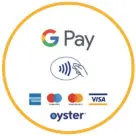TfL signs £2m payments promotion deal with Google Pay

Google has agreed to pay Transport for London (TfL) £2m (US$2.56m) for the right to place Google Pay branding on all of London Underground’s 5,686 tap in/out card readers for a year... More

Google has agreed to pay Transport for London (TfL) £2m (US$2.56m) for the right to place Google Pay branding on all of London Underground’s 5,686 tap in/out card readers for a year... More
Sheep Inc: The world’s first carbon-negative fashion brand — Evening Standard — “Each sweater comes with an NFC tag on the hem, marked with a unique serial number. When scanned with a smartphone, the full details of the garment’s manufacturing journey and carbon-footprint are unlocked… In amongst all the information and insights on material origins, water usage and production techniques that appear when you scan the tag, is also the name of the sheep who provided the wool for your sweater.”
Snapchat is using AR to transform an empty shop into a pop-up Lego Wear Store — Evening Standard — “When you enter the store, you need to scan a Snapcode on the photo-sharing app, which uses augmented reality (AR) technology to showcase the clothes and in-store displays… Prospective buyers can purchase clothing through the integrated ‘shop now’ feature on Snapchat. This takes them through to the Lego Wear e-commerce site where they can select their preferred item and have it delivered to their home.”
Surge in contactless card fraud — stealing £1.8m in 10 months — Evening Standard — “Action Fraud, the national reporting centre for fraud and cybercrime, said that in 10 months last year there were 2,739 reports of contactless fraud, totalling almost £1.8m (US$2.3m) — up from 1,440 cases worth £711,000 (US$909,000) in the same period in 2017… Average losses investigated by detectives were between £90 (US$115) and £652 (US$833) but the largest single contactless case reached £400,000 (US$511,000), stemming from multiple purchases.”
Supermarket checkout designed to scan entire shopping basket trialled in London — Evening Standard — “Each shopping item has a tiny ‘radio frequency identification’ chip embedded in it… The customer first places their items on a scanning platform, which displays the full list on a screen. They open a smartphone app and tap the device on a reader to deduct payment from an account linked to a card app, such as Apple Pay or Android Pay, and are then emailed a receipt.”
Police chief says safer to keep contactless cap at £30 — Evening Standard — “A poll last month found that more than half of retailers wanted the contactless limit increased… About 2.7p (US$0.04) in every £100 (US$129.70) that was spent was lost to contactless fraud last year.”
Transport for London (TfL) has warned commuters of potential risks when using Apple Pay to pay for journeys on the city’s public transport network, including a flat battery that could result in penalty fares and the possibility of being charged twice if they carry both an iPhone and Apple Watch... More

A new ticketing infrastructure designed to support payments via open-loop contactless cards and NFC phones won’t now arrive in time for the Olympics, TfL has revealed. More